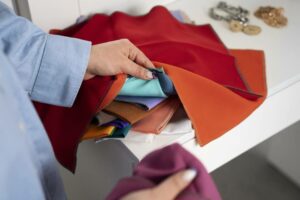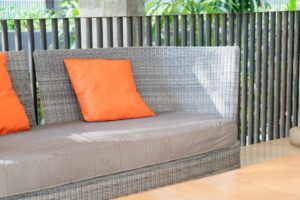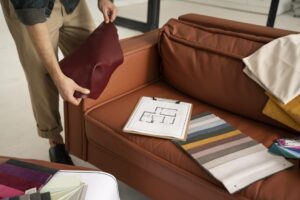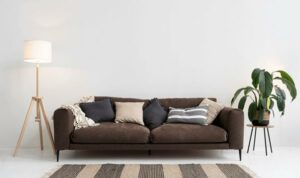When choosing the perfect material for your upholstery needs, acrylic fabric emerges as a standout option, blending durability with aesthetic appeal.
Keep reading to discover what acrylic fabric is, its creation process, its versatile applications in upholstery, and the many benefits it brings to the table.
What is Acrylic Fabric?

Acrylic fabric is a synthetic textile crafted from a polymer known as acrylonitrile, which is produced by reacting specific chemicals sourced from petroleum or coal with various monomers.
These polymers are spun into fine fibres, which are then either woven or knitted into a diverse assortment of fabrics.
Furthermore, for a fabric to be recognised as genuine acrylic, it must comprise at least 85% acrylonitrile.
How is Acrylic Fabric Made?

1. Polymerisation
Acrylic fabric is first polymerised from acrylonitrile, a synthetic monomer derived from petrochemical sources. This leads to the formation of long chains of acrylic polymer, known as polyacrylonitrile.
2. Dissolving
Once formed, the acrylic polymer is dissolved in a chemical solvent, resulting in a gel-like solution.
3. Extruding
The next stage involves extruding the solution through spinnerets, small nozzles equipped with numerous tiny holes, to form acrylic fibres.
4. Wet or Dry Spinning
The acrylic fibres are then subjected to either wet or dry spinning, depending on the required properties of the final fabric.
In wet spinning, the extruded streams of polymer solution enter a chemical bath, where they solidify into fibres.
Dry spinning, on the other hand, involves passing the streams through a heated chamber. Here, the solvent evaporates, leaving behind solid acrylic fibres.
5. Washing and Stretching
Following spinning, the acrylic fibres are thoroughly washed and stretched to form long, thin filaments that contribute to the strength and texture of the final fabric.
6. Loading
The prepared acrylic fibres are then spun into yarn and wound onto bobbins or spools. This form makes it easier to transport the material to textile product manufacturers.
7. Weaving
In the final step, textile manufacturers weave or knit acrylic yarn into various textile products, including apparel, carpeting, upholstery and more.
The versatility of acrylic yarn allows for a wide range of textures, patterns, and colours, making it a favourable choice for residential and commercial upholstery needs.
Read More: Upholstery Furniture Benefits: More Than Just Beauty
How is Acrylic Fabric Used in Upholstery
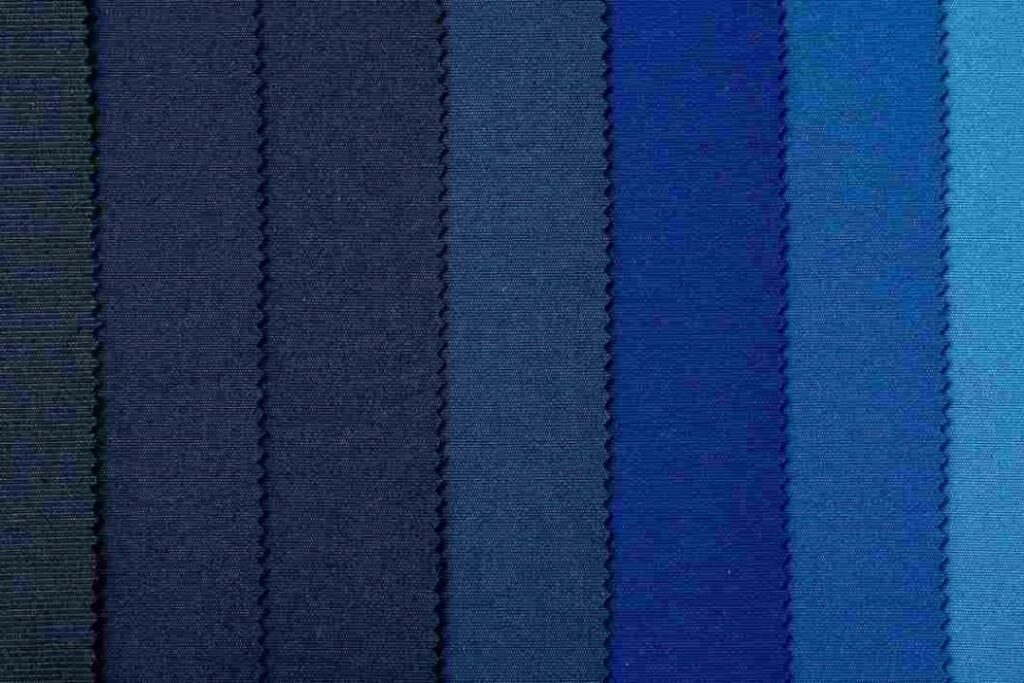
1. Furniture Upholstery
In home decor, acrylic fabric is popular for upholstering furniture pieces like sofas, chairs, and ottomans.
Its softness and texture closely resembles that of natural fibres such as wool, offering a warm, comfortable, and inviting touch to any piece of furniture.
2. Outdoor Furniture
The fabric is also a preferred choice for outdoor furniture cushions and covers.
Its inherent resistance to UV damage keeps colours vibrant and prevents the fabric from breaking down under sun exposure.
Additionally, its water-repellent nature and ease of cleaning ensure that outdoor furniture remains well-kept, season after season.
3. Commercial Upholstery
The resilience of acrylic fabric extends to commercial venues such as restaurants, hotels, and office spaces.
Its robustness makes it an ideal candidate for high-traffic areas, offering excellent resistance to wear and tear.
Moreover, its ability to resist stains ensures that furniture in these settings maintains a pristine appearance with minimal upkeep.
4. Automotive Upholstery
Acrylic fabric is used even in the automotive industry, particularly in the upholstery of car interiors, including seat covers and headliners.
The fabric’s durability is a key asset here, as it ensures that the interior maintains its look and feel, contributing to the vehicle’s overall longevity and appeal.
What are the Benefits of Acrylic Fabric for Upholstery
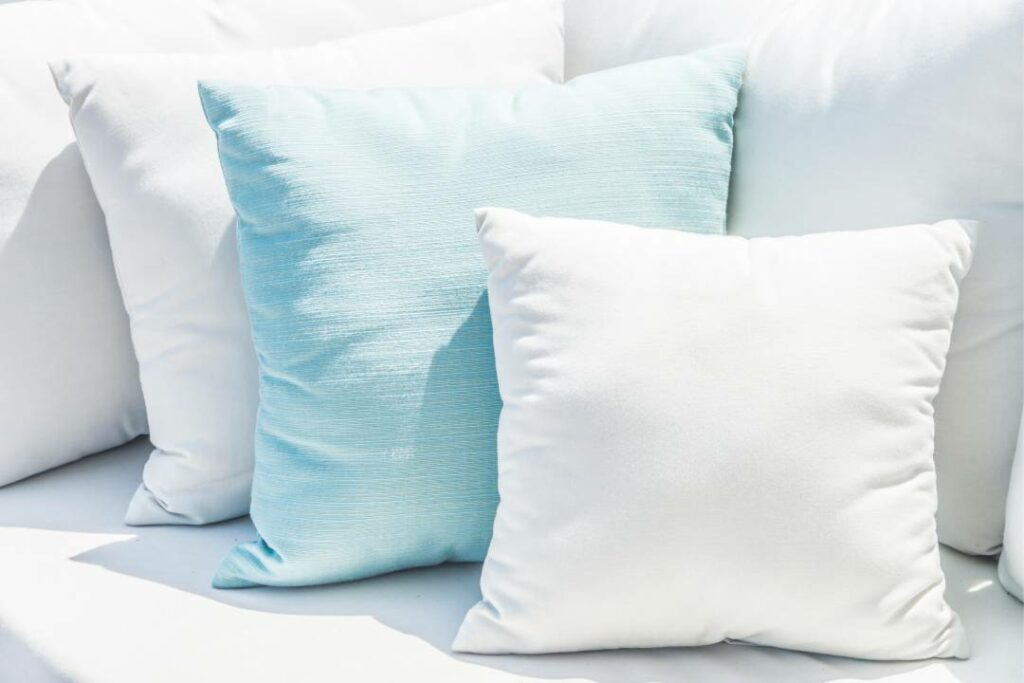
Acrylic fabric offers many benefits for upholstery, making it a favoured choice among homeowners and designers alike. They include:
1. Durability
One of the standout qualities of acrylic fabric is its exceptional durability.
Designed to withstand regular use, acrylic upholstery is less prone to wear and tear, maintaining its integrity and appearance over time.
2. Moisture Resistance
Acrylic fabric’s inherent moisture resistance is another key benefit, especially for outdoor furniture.
It repels moisture effectively, preventing it from seeping into the fabric. This characteristic also contributes to its resistance to mould and mildew, ensuring that your upholstery remains clean and hygienic.
3. Colourfastness
The fabric’s vibrant appearance of is not fleeting; thanks to its excellent colourfastness, it retains its colour brilliantly in the long run.
4. Easy Maintenance
Maintaining the pristine appearance of acrylic fabric upholstery is relatively straightforward.
It typically requires simple cleaning methods, although adhering to the manufacturer’s specific care instructions is always wise.
5. Fade Resistance
Exposure to sunlight can cause many fabrics to fade, but acrylic fabric boasts strong resistance to UV radiation.
This fade resistance ensures the fabric maintains its colour and appearance even when used in sunny areas or outdoors.
Read More: Why is Fabric Colour Important in Interior Space Design
Enhance Your Decor with Durable Acrylic Fabrics from Kintex
In conclusion, acrylic fabric offers a versatile and reliable solution whether you’re redecorating your living space, outfitting outdoor furniture, or selecting upholstery for high-traffic commercial settings.
Kintex is a leading upholstery material and outdoor fabric supplier in Malaysia. Our upholstery and outdoor fabric collections feature a wide array of patterns, colours, and textures designed to meet all your fabric needs.


